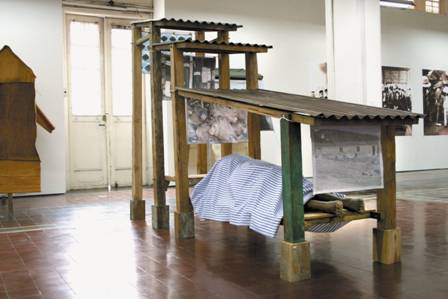 |
|
|---|---|
| CP Foundation | About CP Biennale | 2003 | 2005 | Contact Us | |
         
|
|
|
Citytalk (above) Mella Jaarsma (born 1960 in Emmeloord, The Netherlands) finished her study in the Minerva Art Academy in Groningen in 1984, then moved to Indonesia to study at the Jakarta Art Institute and the Indonesian Institute of the Arts, Yogyakarta. Since then she has been living and working as an artist in Yogyakarta. Some of her solo exhibitions are: “Asal” (Origin) at the Etemad Gallery, Tehran, Iran (2005); “The Shelter” at the Valentine Willy Gallery, Malaysia (2004); “The Warrior” at the Jaske Gallery, Sydney, Australia (2003); “Moral Pointers” at the Lontar Gallery, Jakarta (2002); and “I eat you eat me,” curated by Dr. Apinan Poshyananda, at the Center of Academic Resources, Chulalongkorn University, Bangkok, Thailand (2001). Creating shelters is related to the history of mankind. Shelters are human habitats, physical and psychological territories found all around the world, providing protection and comfort. Civilization has layered the shelter through with many other meanings connected with wealth, status, religion, family life, notions of community, and privacy. The shelter or the house is an extension of our own body, our cloths, and our personal space. This space reflects the development from being into well-being, showing the targets of human beings to settle and enrich themselves. This aim for prosperity and well-being is rooted in our genes and psyche. In the works for the CP Biennale, I want to show different aspects of those searched mental secure spaces related to the insecure urban environment. The city itself has the imago of disruption, arrogance, decadence, frivolity, chaos, and destruction. The city is the gathering place for trade and sins, and building a city brings the consequences of fear for attack and annihilation. Myths of destroying the city already exist as long as people are building cities and doing businesses, collecting wealth and knowledge (Babylon). As Ian Muruma and Avishai Margalit wrote in their book Occidentalism, The West in the Eyes of Their Enemies: “Trade is of course not a Western invention, but modern capitalism is. Trade as a universal system—that has its origin in the most important cities in the West, and conquered old and new world empires with the pretension to create a worldwide civilization—is in the eyes of those that consider themselves as guards of tradition, culture, and religion, a plot to destroy everything that is profound, authentic, and spiritual.” In this book it is argued that the source of the stereotypes that heated the hate feelings of Bin Laden, can be found in the West itself. The belief in improvement, from the Western point of view is seen as enlightenment (French Revolution) and Leon Trotsky saw the history of capitalism as a victory of the city over the countryside. The godless (read: Westernized) city against the righteous countryside. Recklessness, lust of power, free thoughts, individualism, and the power of money—these are all associated with people living in the city. Most religions propagate the fear for punishment, when individual pride takes over the power of God and when we think that we can manage ourselves alone. In the aim for prosperity and comfort, the city inhabitant is often seen as a deceiver and prostitute. (Artist's Statement) |
|
|
CP foundation | About CP Biennale | 2005 Biennale | 2003 Biennale | Contact Us
Jl. Suryopranoto 67A, Jakarta 10160, Indonesia. ph. +62.21.3448126, 3853206 | fax. +62.21.3853203, 3853208 info@cp-foundation.org |

